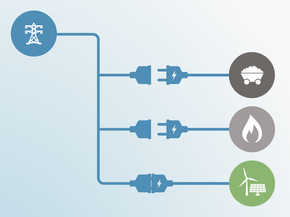Country summary
Overview
Australia still has a lot of work to do to address its climate policies: it is not on track to meet its renewables target; its flagship industrial emissions policy allows more fossil fuel emissions, and its support for the fossil fuel industry – especially exports – remains unwavering. Australia’s overall rating remains "Insufficient." The re-elected Albanese government will have to work to bring its climate action up to a standard that withstands global scrutiny as it campaigns to host COP31 in 2026.
Australia has yet to submit a 2035 emission reduction target. Its current 2030 NDC target – a reduction of 43% below 2005 levels – is not aligned with 1.5°C: this would require significant strengthening. The government’s projections (December 2024) indicate that it may already be close to meeting its 2030 target (42.6% reduction). While this is partly due to the rollout of renewables in the power sector, it is also down to an increase in projected land use, land use change and forestry removals, which has little to do with policy. Excluding the land and power sectors, emissions from all other economic sectors are projected to be 4.5% above 2005 levels in 2030 (only 5% below 2024 levels).
For 1.5°C compatibility, Australia would need to cut emissions by at least 57% below 2005 levels by 2035 excluding LULUCF, and at least 76% when including LULUCF.
The government's two main policies covering emissions are the renewables target in the power sector (35% of total emissions) and the Safeguard Mechanism (SGM) which covers large-scale emitters in the industrial sector (31% of total emissions).
Australia has an 82% target by 2030 for on-grid renewable electricity generation, supported by its expanded Capacity Investment Scheme (CIS). However, the government’s own estimates show that accounting for off-grid power generation means an 82% on-grid renewables target would be only 77% nation-wide by 2030.
While the government projects it will meet its 82% target, the independent Climate Change Authority finds that an additional 8 GW of utility-scale renewable energy projects are required on top of the expanded CIS. The International Energy Agency projects that, based on current policies and deployment trends, the share of renewables in Australia’s power mix will only reach 58% by 2030, well below the government’s target. In this scenario, where barriers to renewables deployment are not addressed, the CAT estimates that Australia’s 2030 emissions, excluding LULUCF, would be 10% higher than government projections.
The “Safeguard Mechanism” (SGM), which is the core policy for reducing industrial emissions, is an example how offsetting delays or avoids decarbonisation. The nominal SGM target requires emissions to decline to 100 MtCO2e by 2030, or 28.1% below 2023. However, it also allows the industries it covers to meet this target with offsets. Currently less than a third of the ‘reductions’ achieved were from real emission reductions and two thirds due to the use of offsets. This undermines the effectiveness of the mechanism, so the real emissions reductions are therefore unlikely to be close to the nominal target and the covered sectors will not be able to decarbonise as required by Australia’s net zero target.
The most recent emission inventory shows that emissions from the fossil fuel industry, agriculture, and waste sectors continue to flatline, as the government's ongoing reliance on – and revision of – its land sector for emission removals gives the appearance of action where there has been little.
Australia still lacks federal-level strategy, plans or committed timelines for a transition away from coal and fossil gas as agreed at the first Global Stocktake at COP28. Instead, the government has continued to approve coal and gas projects. Seven new coal mine projects in 2023 and 2024 will allow coal mining and exports to continue for decades to come. Shortly after returning to power in May 2025, it approved a 40 year lifetime extension to Woodside Energy’s massive North West Shelf LNG Plant, allowing it to operate until 2070 – decades beyond the point when Australia is meant to have reached net zero. The facility will be able to essentially triple its historical emissions. This is incompatible with the Paris Agreement’s goals and with the government’s emission reduction commitments.
As the third largest fossil fuel exporter, Australia’s exported emissions were already more than two times its total domestic emissions in 2022, and its exported emissions almost doubled between 2010 and 2022. Together with domestic emissions, its total GHG footprint adds to about 4.5% of global fossil fuel CO2 emissions.
Under its "Future of Gas Strategy", the government continues to support the oil and gas industry, reaffirming its support for the production and export of fossil gas until 2050 and beyond. Its support of the fossil fuel industry hinges on false solutions such as its support for carbon capture and storage (CCS), and offsets. According to the IEA, no new fossil fuel projects are required in its Net Zero Emissions scenario, which reaches net zero emissions by mid-century in a way that limits global warming to 1.5°C, consistent with the Paris Agreement’s long-term temperature goal.
The rollout of electric vehicles in Australia lags behind most OECD countries, and holistic transport policies, which consider public transport, freight, and modal shift, are still missing and Australia was the last developed country but Russia to adopt a (weak) vehicle efficiency standard in 2024. As a result, the transport sector is projected to become the country’s greatest source of emissions by 2030. Australia will need to adopt more ambitious climate policies and take further action to reach 1.5ºC Paris Agreement compatibility. Time is running out in the crucial period to 2030. To improve its climate action, Australia could:
- Decrease its reliance on LULUCF sequestration by implementing ambitious policies in other economic sectors. Australia not only needs to submit an upgraded 1.5°C aligned 2030 target and a new 2035 1.5°C compatible NDC in 2025 but also needs to set targets for genuine emissions reductions from its economy without relying on highly uncertain estimates from the land sector. It should introduce full transparency with respect to its land sector modelling and revisions.
- Stop supporting the fossil fuel industry. Australia increased its subsidies to fossil fuel producers and major users by around 30% from 2022/23 to 2023/24 to a total of around AUD 14.5bn, and budget estimates indicate this will further increase (The Australia Institute, 2024). Australian governments, state and federal, need to cease this support and stop other administrative and political support for coal and gas projects, halt new developments, and establish a framework to shift away from fossil fuel exports.
- Accelerate the phase-out of fossil fuelled power generation by streamlining regulatory approvals that are slowing investment in large-scale renewable generation and storage, accelerate grid modernisation and expansion, incentivising demand-side management, and planning the phase-out of coal by 2030 and gas-fired plants by the mid-2030s – including off-grid – in a fair and just way.
- Foster the decarbonisation of the transportation sector through policies to accelerate the deployment of electric vehicles, public transport planning, incentives for modal shift, and transition pathways for heavy mobility.
- Address emissions from the agriculture, waste and buildings and industry sectors, with targeted policies that guarantee a fair and just transition.
- Transition Australia’s industry to future-oriented, low-carbon exports, by exploiting its vast renewables potential and mineral resources, without backing false solutions such as offsets and carbon capture and storage.
Positive developments worth highlighting:
- Australia’s AUD 22.7bn (USD 14.9bn) Future Made in Australia plan sets out a vision for Australia to capitalise on its substantial renewable energy and critical mineral resources and to attract investment in clean industries. The updated 2024 National Hydrogen Strategy specifically focuses on renewable-based hydrogen production, rather than fossil fuel-derived hydrogen. If successfully implemented, these plans could provide a pathway out of reliance on coal and gas exports.
- Australia’s States and Territories continue to lead the way on climate action, with all except for Western Australia and the Northern Territory having their own 2030 targets. Momentum in state-led action remains tied to political support. Queensland hit its 2030 target a decade early, but the new state government has announced a review of the legislated GHG reduction plan released in 2024, which could lead to its withdrawal.
Description of CAT ratings
The CAT rates each country’s targets and policies against (1) its fair share contribution to climate change mitigation considering a range of equity principles including responsibility, capability and equality, and (2) what is technically and economically feasible using modelled domestic pathways which in absence of a better method are based on global least-cost climate change mitigation.
Comparing a country’s fair share ranges and modelled domestic pathways provides insights into which governments should provide climate finance, and which should receive it. Developed countries with large responsibility for historical emissions and high per-capita emissions, must not only implement ambitious climate action domestically but must also support climate action in developing countries with lower historical responsibility, capability, and lower per-capita emissions.
The CAT rates Australia’s climate targets, policies and climate finance as “Insufficient." The “Insufficient” rating indicates that Australia’s climate policies and commitments need substantial improvements to be consistent with the Paris Agreement’s 1.5°C temperature limit.
To improve its rating, Australia needs to set a more ambitious 1.5°C aligned 2030 target for emissions reductions, establish policies to reach its objectives, and provide more finance to support others.
Australia’s current policies are rated as “Insufficient” against modelled domestic pathways. This rating indicates that Australia’s climate policies and action needs substantial improvements to be consistent with modelled domestic pathways limiting warming to 1.5°C. If all countries were to follow Australia’s approach, warming would reach over 2°C and up to 3°C.
The government has yet to take the necessary steps to put the country on track to limit global warming to 1.5°C below pre-industrial levels. Current policies are on track to reduce Australia’s total emissions, excluding LULUCF, by 15–23% below 2005 levels by 2030.
While the government projects reaching its target of 82% on-grid renewable generation by 2030, progress has been too slow to stay on track. The Climate Change Authority estimates that the pipeline of renewable energy projects falls short by 8 GW of what is required to achieve the government’s target. Given that a significant amount of generation is off-grid (~10%) and not addressed by current policy, even if the 82% target is met, total electricity generation would only be 77% renewable by 2030, well below a 1.5°C aligned pathway. The International Energy Agency projects that, by 2030, the share of renewables in Australia’s power mix will reach 58%, falling short of the government’s target.
The government is relying heavily on a LULUCF sink to reach its climate targets, with both historical and projected sequestration figures revised significantly upwards in recent years.
Since 2018, the government has repeatedly revised its land sector sequestration projections, creating the illusion of action. For example, by 2024 Australia had achieved net emission reductions of 28% below 2005 levels – including LULUCF – but in reality, without this sink, actual (gross) emissions had only dropped by 2%. This ongoing revision of Australia’s historical and projected LULUCF estimates erodes the ambition of its NDC for fossil fuel and industrial emissions, the main drivers of climate change, and where the government holds the most leverage.
The Safeguard Mechanism, reformed in 2023, is the government’s main policy for reducing industrial emissions. While it is too early to assess the impact of these reforms due to the mechanism’s design, many SGM facilities rely heavily on offsets rather than direct on-site emissions reductions, undermining gross emissions reductions. Modelling indicates that the reductions in actual emissions from the SGM are likely to be only about 12% below 2023 levels, with 58–68% of the SGM net reduction target met with offsets. While the SGM does include a complex limit on “gross” emissions, this could be met with real emissions only about 2% lower than in 2023 – in other words SGM facility emissions may only be capped at around 2023 levels until 2030.
The government’s introduced its long-awaited New Vehicle Efficiency Standard (NVES) in 2024 as a CO2 emission intensity standard and will take effect from mid-2025. Implemented as a national limit on grams of CO2/km driven, it is averaged across all new cars sold, with each manufacturer getting a weighted allocation that can be sold to others if over-achieved or subject to fines if not. The government’s impact assessment indicates that this would reduce cumulative emissions from passenger cars and light commercial vehicles by around 16 MtCO2e for the period 2025–2030 or about 11% below 2025 emissions levels by 2030. Ahead of this policy, Australia was, along with Russia, among the few developed economies to lack such measures.
The full policies and action analysis can be found here.
The CAT continues to rate Australia’s 2030 NDC target as “Insufficient” when compared to modelled domestic emissions pathways. Australia’s NDC targets emissions 43% below 2005 levels by 2030, including LULUCF.
Although Australia’s NDC lands right at the bottom end of the “Insufficient” range, the quantification of its target is impacted by continuous recalculations of LULUCF sinks estimates for 2030. These have systematically increased year-on-year, thereby reducing the amount of action Australia needs to take on reducing fossil fuels and emissions in other sectors to meet the NDC target.
Excluding LULUCF, the NDC target equates to a reduction of 23% below 2005 levels by 2030. A 2030 NDC target in line with 1.5°C compatible modelled domestic pathways for Australia would require emissions reductions of at least 41% below 2005 levels by 2030 excluding LULUCF, and 60% when including LULUCF.
Australia has yet to submit a 2035 target. For 1.5°C compatibility, Australia would need to reduce emissions 57% below 2005 levels by 2035 excluding LULUCF, and 76% when including LULUCF.
Projections for LULUCF sequestration in 2030 increased fourfold between the government’s 2021 and 2024 projections. This reduces the emissions reduction task for energy, industry, agriculture and waste.
The “Insufficient” rating indicates that Australia’s NDC target in 2030 needs substantial improvements to be consistent with modelled domestic pathways limiting warming to 1.5°C. If all countries were to follow Australia’s approach, warming would reach over 2°C and up to 3°C.
The CAT rates Australia’s 2030 NDC target as “Insufficient” when compared to its fair share emissions allocation. The “Insufficient” rating indicates that Australia’s NDC target in 2030 needs substantial improvements to be consistent with its fair share of the global mitigation effort to limit warming to 1.5°C.
Australia’s target is at the least stringent end of what would be a fair share of global effort and is not consistent with the 1.5°C limit, unless other countries make much deeper reductions and comparably greater effort. If all countries were to follow Australia’s approach, warming would reach over 2°C and up to 3°C.
Australia needs to improve its fair share contribution through both strengthened domestic emissions reductions as well as financing additional climate action in developing countries.
Australia’s international public climate finance contributions are rated “Critically insufficient." This rating indicates that Australia’s climate finance contributions to date are low and not in line with any interpretation of a fair approach to meeting the Paris Agreement’s 1.5°C limit.
At COP28, Australia pledged to stop financing fossil fuel projects abroad within a year. Although the international fossil fuel financing rating improved from “Highly Insufficient” to “Insufficient”, Australia’s overall climate finance rating remained unchanged. To receive a better rating, Australia must increase the level of its international climate finance.
Australia’s maximum land use, land use change and forestry (LULUCF) net emissions in the last 30 years are greater than 30% of total emissions.
The government intends to meet its NDC and net zero target by an over-reliance on LULUCF as a carbon sink (see the "Forestry" section in Policies and Actions). The government regularly recalculates LULUCF for historical and projected emissions. The extent of these recalculations highlights the uncertainty of this sector: data and methodological changes have significant repercussions on Australia’s progress in meeting emissions targets have specifically and systematically reduced the level of emission reductions needed from fossil fuel, industry, transport and other sectors.
Continued revision of Australia’s historical and projected LULUCF estimates erodes the ambition of its NDC for fossil fuel and industrial emissions, the main drivers of climate change, and where the government holds the most leverage. Effective climate policies are needed to decarbonise all sectors in line with the 1.5°C temperature limit irrespective of projected LULUCF sequestration, which is inherently uncertain.
We evaluate the net zero target as "Poor."
An updated Net Zero Plan is under development by the government but is yet to be published. Australia’s current long-term emissions reduction plan, also submitted to the UNFCCC as a Long-Term Strategy (LTS), was published in 2021. The LTS sets a net zero emissions target for 2050. Yet the strategy presents scenarios which only reduces emissions by 60% below 2005 excluding LULUCF, leaving large residual emissions to be compensated for by assumed land sequestration of carbon, other CDR, or the acquisition of international offset units. It does not introduce any new policies, and relies on global technology trends, carbon offsets and further unknown technology “breakthroughs”.
There are also no plans in the document to phase out coal, curb fossil fuel exports, nor to hold heavy polluters accountable. The government legislated its net zero and 2030 targets in September 2022.
It is still possible for Australia to get emissions onto a pathway to limit global warming to 1.5℃ this century, but urgent action is required. The full net zero target analysis can be found here.
Further analysis
Latest publications
Stay informed
Subscribe to our newsletter






